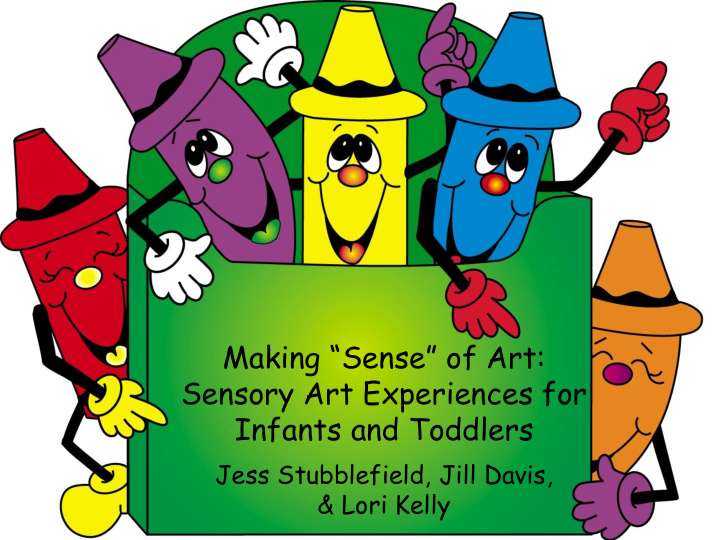



Making “Sense” of Art: Sensory Art Experiences for Infants and Toddlers Jess Stubblefield, Jill Davis, & Lori Kelly
Why Art? (Yes… the research)
One of Gardner ’ s eight intelligences is spatial intelligence, which involves learning, exploring, processing and excelling through the use of the visual arts (1983). Gardner, H. (1983). Frames of Mind: The theory of multiple intelligences . New York: Basic Books
Young children feel a sense of emotional satisfaction when they are involved in making art. This satisfaction comes from the control children have over the materials they use and the autonomy they have in the decisions they make (Schirrmacher, 1998). Schirrmacher, R. (1993). Art and creative development for young children (2nd Ed.). Albany, NY: Delmar.
Making art also builds children's self-esteem by giving them opportunities to express what they are thinking and feeling (Klein, 1991). Klein, B. (1991). The hidden dimensions of art. In J.D. Quisenberry, E.A. Eddowes, & S.L. Robinson (Eds.). Readings from childhood education (pp. 84-89). Wheaton, MD: Association of Childhood Education International.
Exploring materials is very important because it is through exploration that children build a knowledge of the objects in the world around them (Kamii and DeVries, 1993). Kamii, C., & DeVries, R. (1993). Physical knowledge in preschool education . New York: Teachers College Press.
While making art, young children develop control of large and small muscle groups and also helps children develop eye-hand coordination (Koster, 1997). Koster, J.B. (1997). Growing artists: Teaching art to young children . Albany, NY: Delmar.
Art allows children to represent real objects, events, and feelings. It is a needed outlet for children whose vocabulary, written or verbal, may be limited (de la Roche, 1996). The early use of symbols in artwork provides a foundation for children ’ s later use of words to symbolize objects and actions in formal writing. de la Roche, E. (1996). Snowflakes: Developing meaningful art experiences for young children. Young Children , 51(2), 82-83.
Art or Craft?
What is the difference between art and craft? Art Craft • Open ended • Goal oriented • Unstructured • Structured • Process oriented • Product oriented From the Website: http://www.earlychildhoodnews.com/earlychildhood/article_view.aspx?ArticleID=257
What is the difference between art and craft? Art Craft • Uses basic • Uses specific materials materials • Open ended • Closed ended instruction instruction From the Website: http://www.earlychildhoodnews.com/earlychildhood/article_view.aspx?ArticleID=257
What is the difference between art and craft? Art Craft • Develops feeling • Develops coordinating skills (including skills (including self expression) manipulating materials) From the Website: http://www.earlychildhoodnews.com/earlychildhood/article_view.aspx?ArticleID=257
What is the difference between art and craft? Art Craft • The goal is the • The goal is the process of end product discovery • Outcomes will • Outcomes will look basically the look different same From the Website: http://www.earlychildhoodnews.com/earlychildhood/article_view.aspx?ArticleID=257
What is the difference between art and craft? Art Craft The individualized The cookie cutter process leads to process leads to an individual a cookie cutter product product From the Website: http://www.earlychildhoodnews.com/earlychildhood/article_view.aspx?ArticleID=257
Discussion Which is more likely to be considered developmentally appropriate, art or craft?
Allow children to Give children participate at choices? their own level? Discussion Allow children to experience things Allow for “ hands-on ” ? socialization and interaction with others? Lend itself to being adapted if Allow for beneficial? flexibility, with no “ right ” or “ wrong ” outcome? Encourage Foster children ’ s exploration and positive feelings thinking? about themselves?
Self-Reflection How “ creative ” is your creative art? Is there a “ right ” way or a “ wrong ” way? Or is it open-ended ? Do all of the pieces look basically alike? Or is every child ’ s piece original and unique ? Does it require a great deal of teacher preparation or assistance? Or can the child work independently ? Does the activity emphasize the end product? Or the process and experience ? Is the experience “ Teacher-directed ” and initiated? Or child-directed and initiated ? Whose hands are busier – the child ’ s or the adult ’ s? From: http://123child.com/website-share/D.A.P..pdf
Is it art or is it craft?
Relationship Between Art and Sensory Experiences
Importance of Sensory Experiences • Young children learn primarily through sensory exploration and play • Children make discoveries while interacting with materials during sensory play • Sensory play contributes to brain development
Art Processes and Sensory Experiences
Recommend
More recommend